Cannabis Science Analytics: A Look at Top Authors, Keywords and Trends
A report on the top authors, most prevalent terms, and emerging trends in peer-reviewed cannabis science articles.
In this installment of “Cannabis Crossroads” we examine more than 158,000 peer-reviewed cannabis science articles and report the top authors, most prevalent terms, and emerging trends. Cannabis science is growing rapidly and we used various tools to mine this data to report interesting trends.
What does one do while social distancing during a COVID-19 global pandemic? In this installment of “Cannabis Crossroads” I took on the challenge of exploring more than 158,000 peer-reviewed cannabis articles to determine interesting trends, top authors, and observations. Cannabis science is growing rapidly and we used a powerful analytics platform to take a deep dive into cannabis publications from 1812 to 2020.
Cannabis Article Trends
In the fast-evolving world of cannabis science, it is important to keep informed of new areas of growth and trends in scientific articles. There are a wide variety of tools available for mining peer-reviewed publications. Simple keyword searches can be performed using Google Scholar. To analyze keyword trends, top authors and explore connections between publication datasets, a platform called Dimensions (Dimensions.ai) is extremely powerful yet simple to use. In addition to publications, Dimensions also brings together grants, datasets, citations, alternative metrics, clinical trials, patents, and policy documents. I used the Dimensions platform to review some interesting cannabis science article trends, authors, and citation information with you.
Exploration of the keyword “cannabis” in Dimensions generates 158,835 total articles since 1812. The large growth from 1971 to 2019 is shown in Figure 1. (Note: If you include book chapters, proceedings, preprints, and monographs the total number of publications containing “cannabis” increases to 222,896.)
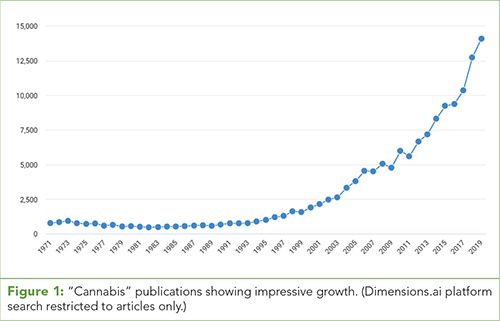
Interestingly, only a small portion of these articles are published in the fields of plant biology (3598 articles) and chemical sciences (5577 articles). A large portion of these articles fall under medical and health sciences (99,932 articles), as shown in Figure 2.
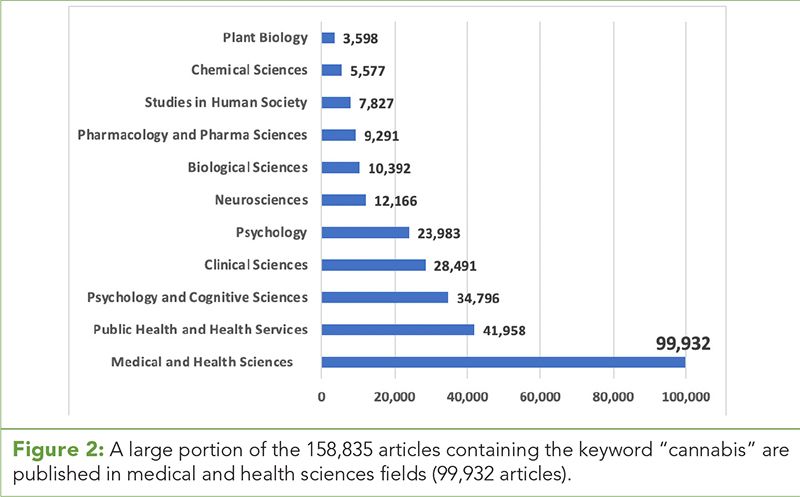
If we look at all fields across all years, there were 17,741 articles that contain the keywords “cannabis” and “chromatography,” and 14,297 articles with the keywords “cannabis” and “mass spectrometry.” Interestingly, there were very large spikes in both datasets in 2010 and 2018. In fact, publications in 2018 outpaced those in 2019 (see Figure 3).
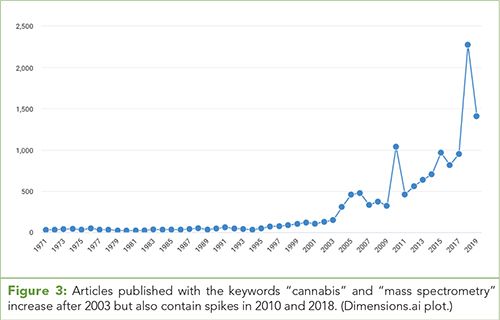
Top Cannabis Authors
The top authors publishing on “cannabis” and “mass spectrometry” are shown in Table I. Marilyn Ann Huestis at Thomas Jefferson University, and formerly with Chemistry and Drug Metabolism at The National Institute on Drug Abuse (NIDA), National Institutes of Health (NIH), has the largest number of publications containing these two keywords (as well as “cannabis” and “chromatography”).
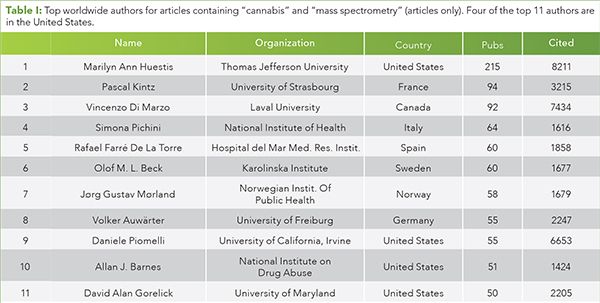
Dr. Raphael Mechoulam, Hebrew University of Jerusalem, Israel, who isolated numerous cannabinoids, including Δ9-tetrahydrocannabinol (THC), and elucidated its structure was the ninth ranked author for “cannabis” and “chromatography.” (Note: If we look at just the keyword “cannabis,” Dr, Mechoulam has 229 articles with more than 21,100 citations.)
Top author honors of all things cannabis, however, go to Robin Macgregor Murray of Kings College London, United Kingdom, with 347 articles mentioning “cannabis.” Louisa J. Degenhardt of The University of New South Wales (UNSW), Sydney, Australia placed second with 308 articles and a whopping 43,867 citations!
Cannabis and Analytical Chemistry
If we narrow the searches to the confines of the analytical chemistry field, we see far less publications containing “cannabis” (2371 articles in total), but we can also see a noticeable increase in the publication rate after 2017, as highlighted in Figure 4.

What is contributing to the growth in cannabis publications in the analytical chemistry field post-2017? Pesticides became a very hot topic and witnessed a surge in publications in 2018 (1367 publications in all fields, with 71 specifically in analytical chemistry). In addition to contaminant testing, many more recent searches show topics of cannabinoid and terpene identifications.
These analytics show not only growth in cannabis science, but also an evolution. A large portion of older cannabis publications are aimed at studies of addiction, drugs of abuse (DAU), psychology, public health, forensics, and health sciences, whereas the more recent topics appear to be focusing on topics such as quality control, exploration of potential therapeutic value, “whole plant” medicine, nutraceuticals, food safety, genetics, and clinical trials. Regardless, such analytics can help us guide our future endeavors in academia, government organizations, R&D, and more. They can also help us find and connect with other authors publishing on similar topics of interest. Knowledge is power, and these analytics can be used to quickly assess current trends and explore new cannabis science boundaries.
Conclusions
I have shared just a few trends and interesting observations here, and I strongly encourage you to explore your own keyword searches using the Dimensions platform. Perhaps you are more interested in keywords such as “cannabis” and “cancer” or exploring beyond publications into the worlds of the 1490 cannabis-specific grants, 24,122 cannabis patents, and 912 cannabis clinical trials listed from a host of international clinical trial registries.
As Albert Einstein said, “Any fool can know. The point is to understand.” I sincerely hope that your own, customized keyword searches and analytics will become an important, guiding step in your journey towards understanding your particular cannabis science fields and that you find the Dimensions platform to be useful. Be safe and be vigilant.
About the Dimensions Data Exploration Platform
Dimensions is a linked research knowledge system that reimagines discovery and access to research. Developed by Digital Science in collaboration with more than 100 leading research organizations around the world, Dimensions brings together grants, datasets, publications, citations, alternative metrics, clinical trials, patents, and policy documents to deliver a platform that enables users to find and access the most relevant information faster, analyze the academic and broader outcomes of research, and gather insights to inform future strategy. For more information about the product have a look at their support site or visit https://dimensions.ai.
About the Columnist
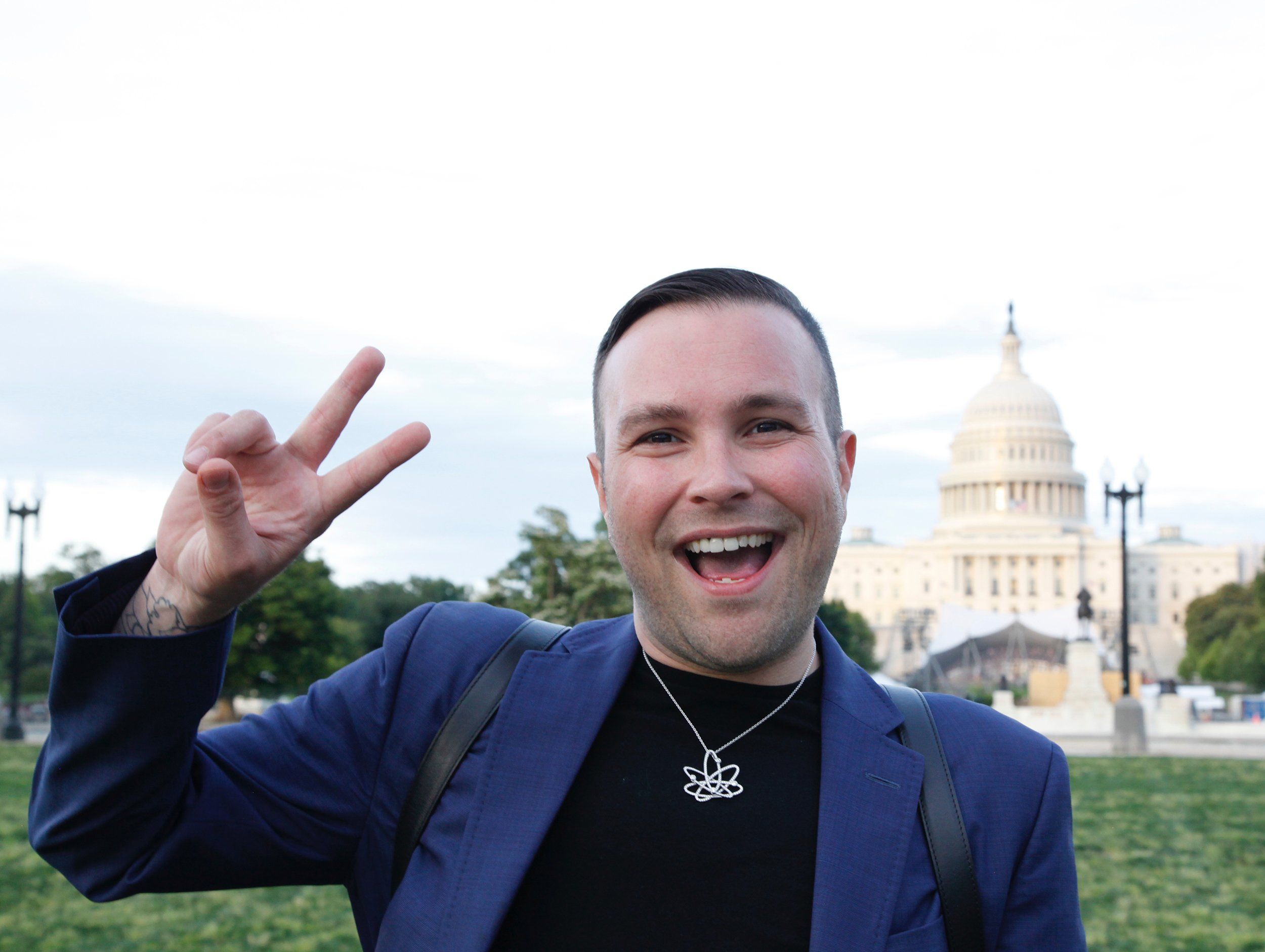
Joshua Crossney is the columnist and editor of “Cannabis Crossroads” and a contributing editor to Cannabis Science and Technology magazine. Crossney is also the president and CEO of CSC Events. Direct correspondence to: Josh@CannabisScienceConference.com
How to Cite this Article
J. Crossney, Cannabis Science and Technology3(3), 30–32 (2020).
Editor's Note
The print version of this article contained the incorrect versions of Figures 2 and 4. The correct figures appear here.

2 Commerce Drive
Cranbury, NJ 08512
All rights reserved.